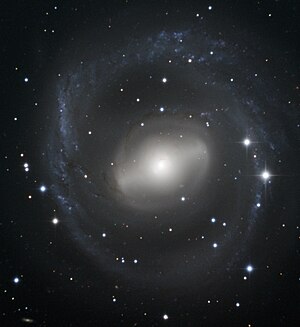NGC 2217
| Galaxie NGC 2217 | |
|---|---|
 | |
| Aufnahme mit dem 3,6-m-Teleskop der ESO am La-Silla-Observatorium | |
| AladinLite | |
| Sternbild | Großer Hund |
| Position Äquinoktium: J2000.0, Epoche: J2000.0 | |
| Rektaszension | 06h 21m 39,8s[1] |
| Deklination | −27° 14′ 02″[1] |
| Erscheinungsbild | |
| Morphologischer Typ | (R)SB(rs)0/a /LINER?[1] |
| Helligkeit (visuell) | 10,7 mag[2] |
| Helligkeit (B-Band) | 11,6 mag[2] |
| Winkelausdehnung | 4,7′ × 4,3′[2] |
| Positionswinkel | 21°[2] |
| Flächenhelligkeit | 13,8 mag/arcmin²[2] |
| Physikalische Daten | |
| Zugehörigkeit | LGG 136 LDCE 435[1][3] |
| Rotverschiebung | 0,005400 ± 0,000017[1] |
| Radialgeschwindigkeit | (1619 ± 5) km/s[1] |
| Hubbledistanz H0 = 73 km/(s • Mpc) | (64 ± 5) · 106 Lj (19,6 ± 1,4) Mpc [1] |
| Durchmesser | 100.000 Lj[4] |
| Geschichte | |
| Entdeckung | John Herschel |
| Entdeckungsdatum | 20. Januar 1835 |
| Katalogbezeichnungen | |
| NGC 2217 • PGC 18883 • ESO 489-G042 • MCG -05-15-010 • IRAS 06196-2712 • 2MASX 06213977-2714014 • AM 0619-271 • GC 1401 • h 3041 • | |
NGC 2217 ist eine linsenförmige Galaxie vom Hubble-Typ SB0-a im Sternbild Großer Hund südlich des Himmelsäquators. Sie ist rund 64 Millionen Lichtjahre von der Milchstraße entfernt und hat einen Durchmesser von etwa 100.000 Lichtjahren.
Das Objekt wurde am 20. Januar 1835 von dem britischen Astronomen John Herschel entdeckt.[5]
NGC 2217-Gruppe (LGG 136)
| Galaxie | Alternativname | Entfernung/Mio. Lj |
|---|---|---|
| NGC 2217 | PGC 18883 | 64 |
| PGC 18765 | ESO 489-029 | 68 |
| PGC 18886 | ESO 426-001 | 72 |
Weblinks
- astronews.com: Bild des Tages 23. Januar 2012
- A Bright Bar of Light (engl.)
- SIMBAD Astronomical Database
- CDS Portal
Einzelnachweise
Auf dieser Seite verwendete Medien
Autor/Urheber: ESO, Lizenz: CC BY 3.0
This image shows the swirling shape of galaxy NGC 2217, in the constellation of Canis Major (The Great Dog). In the central region of the galaxy is a distinctive bar of stars within an oval ring. Further out, a set of tightly wound spiral arms almost form a circular ring around the galaxy. NGC 2217 is therefore classified as a barred spiral galaxy, and its circular appearance indicates that we see it nearly face-on.
The outer spiral arms have a bluish colour, indicating the presence of hot, luminous, young stars, born out of clouds of interstellar gas. The central bulge and bar are yellower in appearance, due to the presence of older stars. Dark streaks can also be seen in places against the galaxy’s arms and central bulge, where lanes of cosmic dust block out some of the starlight.
The majority of spiral galaxies in the local Universe — including our own Milky Way — are thought to have a bar of some kind, and these structures play an important role in the development of a galaxy. They can, for example, funnel gas towards the centre of the galaxy, helping to feed a central black hole, or to form new stars.
Colours & filters Band Wavelength Telescope
Optical B 440 nm ESO 3.6-metre telescope EFOSC
Optical V 547 nm ESO 3.6-metre telescope EFOSC
Optical R 643 nm ESO 3.6-metre telescope EFOSC